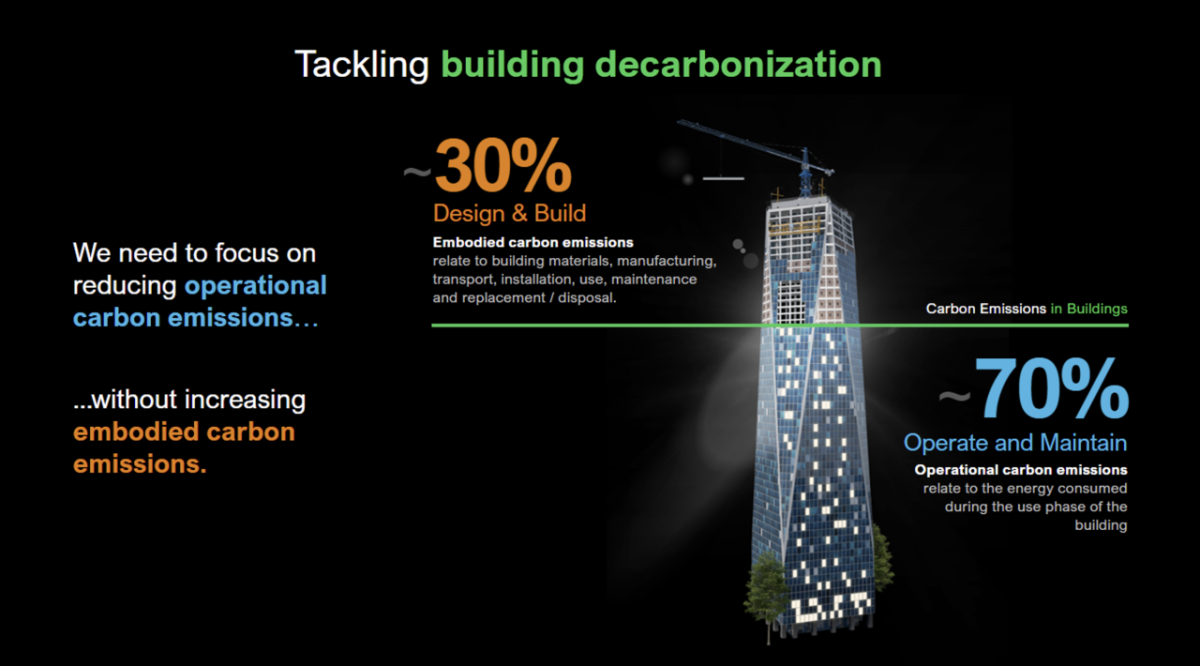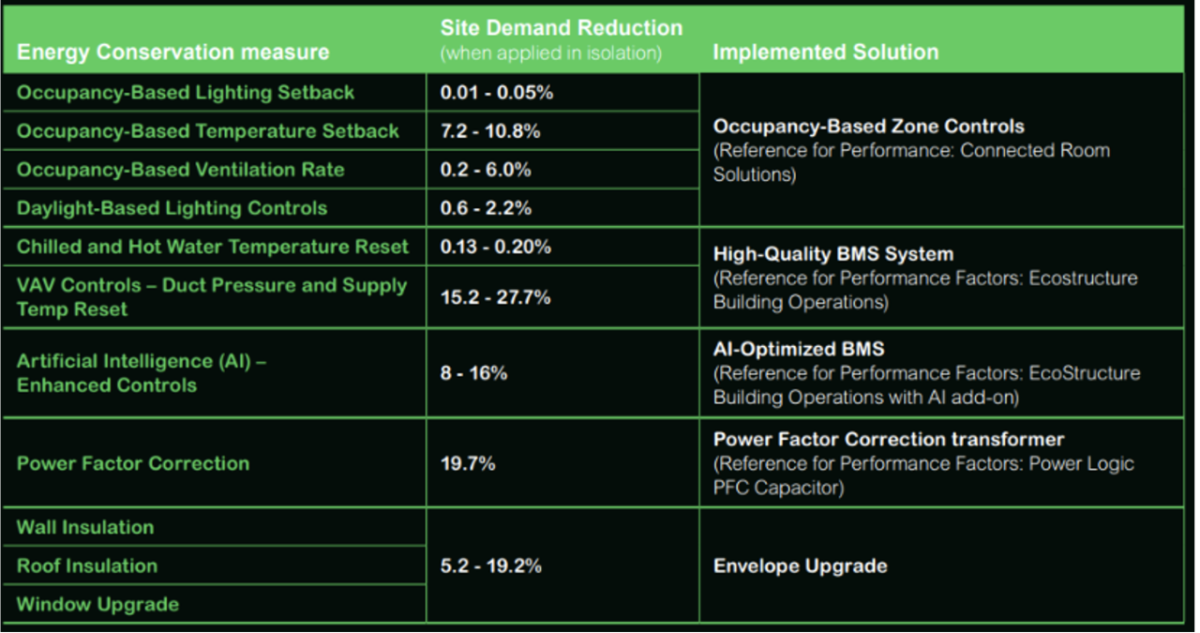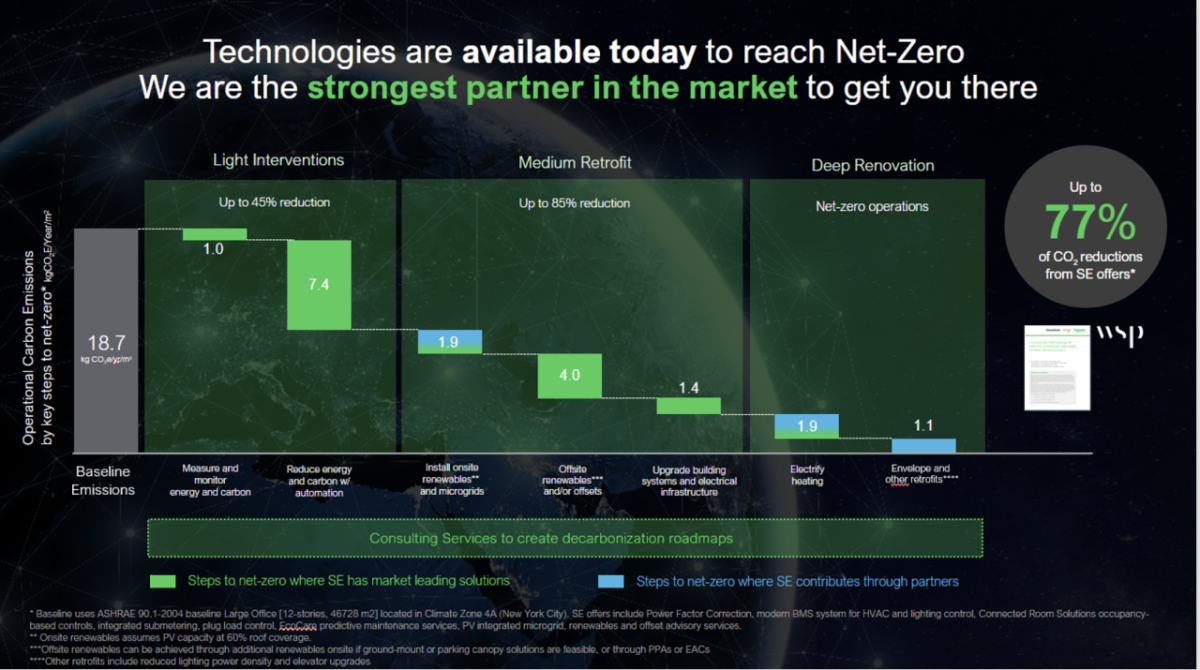A Science-Based Determination: The Fastest Path to Decarbonizing Buildings Is a Digital Technology-First Approach
By Mike Kazmierczak
Buildings play a critical role in the race to meet science-based climate targets
Climate change is one of the biggest challenges to human and planetary well-being. With 37% of global CO2 emissions coming from buildings, it is crucial that buildings are decarbonized in the race to meet science-based climate targets. And, 50% of today’s buildings will still be in use in 2050. The most significant opportunity to accelerate carbon reduction in the building sector is to retrofit existing buildings. It’s the fastest path decarbonizing buildings. Science also shows that sustainable renovations not only deliver sizable energy savings, but they can also deliver significant ROI in less than a decade – as well as attract tenants, preserve asset value, and mitigate financial risk.
Tackling the climate challenge through retrofits
First, it’s important to realize that we are at a crossroads, with a short-term global energy crisis intersecting a longer-term global climate crisis. Energy prices are becoming more volatile while energy supplies are becoming less certain. Meanwhile, maintaining our current pace in tackling climate change means that we will fail to limit global temperature rise to 1.5°C.
While statistics reveal some progress, the pace of carbon reduction is not proceeding rapidly enough.
To stay on track and limit global temperature increases to 1.5°C, we must halve emissions by the end of this decade and reach net zero by 2050. This means we must move 3 times faster to achieve this global target. A pivotal piece to this puzzle is reducing operational emissions caused by building energy consumption by 5% annually between now and 2050.
The path to decarbonizing buildings
Accelerating climate action begins with a stronger focus on retrofitting existing buildings. If we break this down, we find that:
- 30% of carbon emissions are attributed to “embodied carbon” (carbon that is a result of the design and build phase)
- 70% of carbon emissions are attributed to “operational carbon” (carbon that is a result of the operations of a building)
Retrofitting is essential to preserve the value and lease-ability of existing buildings and can meet sustainability standards, attract tenants, and maintain their value in a greener economy. As the large corporations inhabiting these areas strive for net-zero status, they will inevitably demand that the buildings they lease align with their net-zero objectives and demonstrate a tangible progression toward achieving them.
Keep in mind, 90% of existing buildings that fail to decarbonize will become a financial risk and face an asset value discount. This discount could reduce the value of these assets by as much as 30%, making them less attractive to potential investors and tenants.
Although every building is unique, retrofitting an existing building versus building a new design can cut lifetime carbon emissions in half. While a new building may be able to achieve slightly better operational carbon performance than a retrofit, the embodied carbon is typically much higher than a retrofit building where the core and shell are retained.
So, where do you begin?
To meet emissions targets, we must focus on measures with a low carbon footprint, a quick return on upfront emissions, and a low operational profile. These solutions must be adaptable to various building types and climates and rapidly deployed in existing buildings.
Technology-first retrofits. This is where Schneider Electric leads the industry in the path to net-zero building solutions. A digital technology-first approach that relies on modern digital and power management solutions is fastest to implement, lowest in upfront carbon, and most effective from both an ROI and lifecycle carbon perspective.
Our research shows that deploying digital building and power management solutions[i] in existing office buildings could reduce their operational carbon emissions by up to 42% with a payback period of less than 3 years.
Now, let’s look deeper into how we arrived at these numbers.
Science-based study to quantify emissions impact
Schneider Electric partnered with WSP, a global design and engineering firm. Together, we quantified the impact of various efficiency, electrification, and renewable energy building decarbonization retrofit options. We also determined which approaches attain the fastest emissions reduction outcomes.
Our analysis involved the building performance modeling of a baseline office building built to ASHRAE 90.1-2004 standards across various climate zones and with varying grid emissions intensities. The baseline model in New York City, for instance, emits 18.7 kg of CO2 per square meter per year of operational carbon emissions, as the baseline building prototype analyzed (like most existing buildings) relies on fossil fuels for heating and exhibits low rates of electrification and inefficient operations.
Our methodology combined public data sets, Schneider Electric proprietary research, and a parametric modeling approach. This enabled us to understand the trade-offs, benefits, and interactions between a range of office decarbonization strategies, focusing on the solutions from the table below.
To quantify the carbon emissions associated with each measure, we adopted the EN 15978 framework for whole lifecycle impact assessment, and the GWP100 EF6 emissions measure.
This process enabled the comparison of 4,096 variants of the energy model, adding a range of energy conservation measures (ECMs) in different combinations to recreate every possible permutation.
Define your retrofit decarbonization strategy
Schneider Electric has the technologies available today to help you on your path to decarbonization and net-zero buildings.
A critical success factor in achieving rapid building decarbonization involves assessing and prioritizing retrofitting efforts. In our research, three clear categories of opportunity emerged. We refer to these three categories as light, medium, and deep renovations. In defining the right retrofit strategy, it is crucial to consider the entire building and portfolio ownership period, as well as the potential risks associated with asset stranding due to local market conditions, and other factors beyond ROI and carbon footprint.
Let’s take a closer look:
LIGHT INTERVENTIONS: COMPLIANCE & EFFICIENCY
Light renovations are inclusive of 100% digital solutions. They are characterized by high ROI with low up-front investment and low disruption to building occupants. Building owners should start by monitoring and measuring building energy consumption. Establishing a baseline is essential before reducing carbon emissions. These initial steps can result in a 45% reduction in operational carbon emissions.
The primary gains come from automated building controls, particularly involving HVAC system controls optimization and sensors that help to regulate HVAC equipment settings (39.6%). The remaining savings from light interventions come from monitoring and measuring energy consumption, making usage more visible to identify waste (5.3%). Light interventions help meet reporting and compliance needs and reduce energy and carbon emissions. The cost for implementing such renovations will range between 20€ and 35€ per square meter (m2), with an ROI between 1 and 3 years.
MEDIUM RETROFITS: COMPETE IN THE MARKET
Medium retrofits are more intensive, cause more disruption to operations, and have higher embodied carbon, but deliver greater operational carbon reductions. These include onsite renewable energy solutions, battery energy storage, and microgrids, with electrical distribution solutions that deliver additional efficiency gains and improve power quality. Coupled with light intervention solutions, medium retrofits can reduce operational carbon emissions by up to 85%.
Medium renovations involve the implementation of onsite renewables like rooftop solar panels (PV) and managing energy generation and storage with a microgrid, which can generate 10.2% in annual operational carbon reduction. Where onsite renewable potential is constrained to the rooftop, additional emissions reductions can be achieved through offsite renewables solutions like Power Purchase Agreements (PPAs) or carbon offsets, if needed. The model used these solutions to address residual emissions and contributed 21.4% potential annual operational CO2 emissions reduction. With more electrified loads and dynamically changing loads, power factor correction and harmonic filtering may be required and can contribute an additional 7.5% in operational carbon emissions reduction. The cost for implementing such medium retrofit solutions will range from 115–175 €/m2, with an ROI between 6–10 years.
DEEP RENOVATIONS: LEAD THE MARKET
At some point, achieving net zero carbon emissions will also require deep renovations. At this stage, full electrification and building envelope improvements are implemented. These changes will be even more disruptive, take longer to implement, and typically involve temporarily relocating tenants. Such renovations include upgrading roof and wall insulation, converting windows from single to triple-paned glazing, modernizing elevators, and electrifying the building’s heating system, reducing emissions the rest of the way to reach net zero after medium retrofits. The cost for implementing such renovations will range from 500–1.300 €/m2, with an ROI of 25+ years.
A discussion with Forbes
During the 2023 Forbes Sustainability Leaders Summit, I had the honor of sitting with Diane Brady, Assisting Managing Editor at Forbes to give my perspective and share our science-based knowledge and digital technology-first methodology.
I invite you to listen to these brief excerpts from our interview:
- Part I: Working toward a more sustainable future
- Part II: The importance of a technology-first approach
Let’s get started
The results of our science-based research, backed by the collaboration with WSP, provide a fundamental and data-proven foundation for building owners to act and reap the benefits – all while contributing to a more sustainable future.
To learn more about our science-based research and data, download the following white papers:
- A structured methodology for planning commercial real estate portfolio decarbonization
- Decarbonize the office: Unleash the power of digital solutions for building renovations
- Decarbonize the office: Accelerate with electrification
Contact Mike Kazmierczak, VP of Schneider’s Decarbonization Office, or Schneider’s Sustainability Consulting Team to engage in a more in-depth discussion.
[i] Schneider Electric solutions include EcoStruxure Building Operation, EcoStruxure Building Advisor, Connected Room Solutions, Accusine power factor correction and harmonic filtering, PowerLogic submetering








